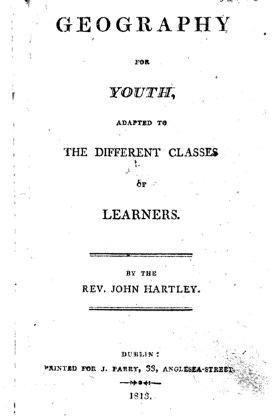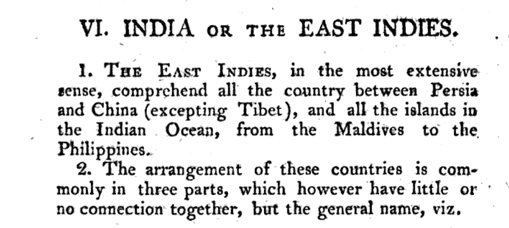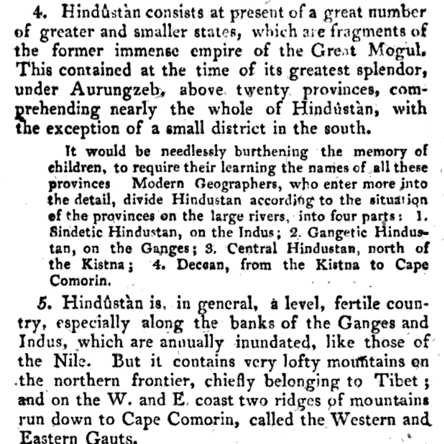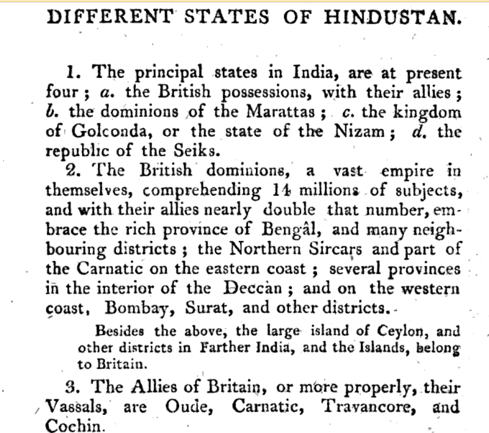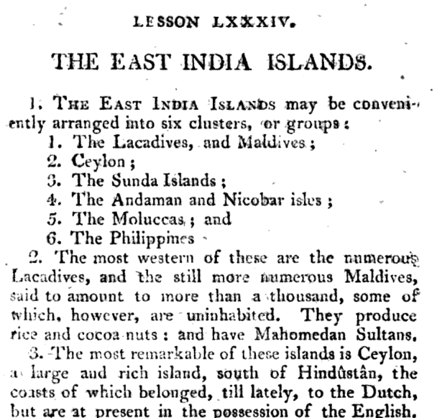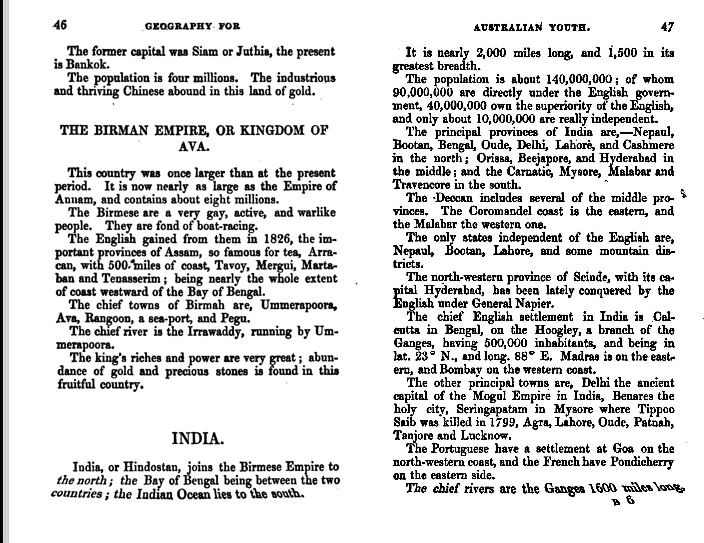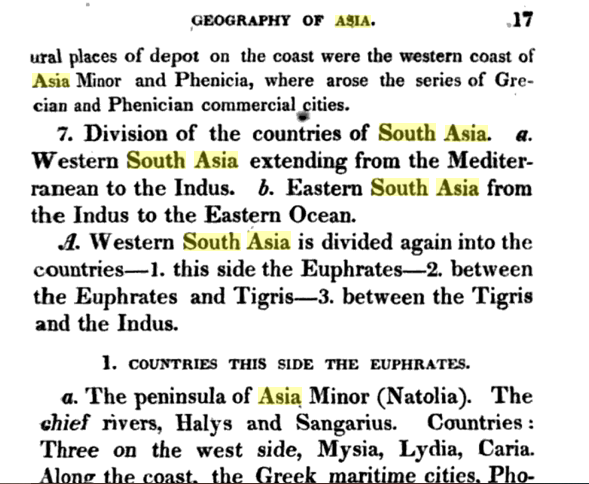Thread / Spam
A lot of tweets already been spent on this 'India vs S Asia' discussion.
So, apologies to those have exposure to my tweets.
But making an attempt to get it more organised.
Among other things, the Professor from Europe stated the following +
A lot of tweets already been spent on this 'India vs S Asia' discussion.
So, apologies to those have exposure to my tweets.
But making an attempt to get it more organised.
Among other things, the Professor from Europe stated the following +
1. Can't use India for pre British era. Basically implying that 'India' in pre British era meant something significantly different from what it means now.
2. 'South Asia' is not new coinage, it has been there for couple of centuries.
We look at both the assertions.
2. 'South Asia' is not new coinage, it has been there for couple of centuries.
We look at both the assertions.
For the meaning 'India', we take a look at contents of a book named 'Geography For Youth' written by John Hartley and published in 1813.
Year of publication is significant because the British still haven't captured whole of India. Neither Marathas nor Sikhs have been vanquished
Year of publication is significant because the British still haven't captured whole of India. Neither Marathas nor Sikhs have been vanquished
This is how the book defines India:
"The country between Persia and China(excepting Tibet) and all the Islands in Indian ocean from Maldives to Philippines."
"The country between Persia and China(excepting Tibet) and all the Islands in Indian ocean from Maldives to Philippines."
It further divides India into 3 parts
1. Hindustan
2. India beyond Ganges
3. The East Indies.
So we can see that even before the completion of British conquest both terms 'India' as well as 'Hindustan' are in existence.
So one cannot say British territory = India
1. Hindustan
2. India beyond Ganges
3. The East Indies.
So we can see that even before the completion of British conquest both terms 'India' as well as 'Hindustan' are in existence.
So one cannot say British territory = India
Here some more detail on 'Hindustan'. Clearly refers to Aurangzeb's territory as 'Hindustan" which is more or less the classic Himalaya to Indian Ocean and Arabian sea to Bay of Bengal sea geography.
Here more clarity on how British territory is not same as India.
"Prinicpal states in India, are at present four;"
These 4 states : 1. British 2. Marathas 3. Nizam 4. Sikhs
So, very clear that idea of India definitely predates the British.
'British dominions' is NOT India.
"Prinicpal states in India, are at present four;"
These 4 states : 1. British 2. Marathas 3. Nizam 4. Sikhs
So, very clear that idea of India definitely predates the British.
'British dominions' is NOT India.
This is the 2nd component of India : India beyond Ganges
This includes Burma also. So that's some deviation from current India and undivided India.
This includes Burma also. So that's some deviation from current India and undivided India.
Third and final components that has Ceylon ( Sri Lanka) and other smaller islands. What was amusing for me was Philippines being part India.
Note, one of the prof's argument was that S. Lanka could not have been accommodated within 'India' but we can see that it actually was.
Note, one of the prof's argument was that S. Lanka could not have been accommodated within 'India' but we can see that it actually was.
Summing up this part :
1. Notion of India clearly predates British arrival.
2. India was not 1 political unit but it was distinct geographical unit (cultural too but talking only what I've shared)
3. The geography of this old 'India' is roughly same as pre partition India.
1. Notion of India clearly predates British arrival.
2. India was not 1 political unit but it was distinct geographical unit (cultural too but talking only what I've shared)
3. The geography of this old 'India' is roughly same as pre partition India.
The geographical spread of India confirmed again by this book named ' Geography for Australian youth' published in 1845 (which is still before British conquest of Punjab)
Having looked at the issue of 'India' before 1947, let's come to 'S Asia'.
Was the term in usage before 1947?
Yes it was
Did it refer to the same or roughly the same area that it refers to now ?
NO. It is very different. A huge difference.
Was the term in usage before 1947?
Yes it was
Did it refer to the same or roughly the same area that it refers to now ?
NO. It is very different. A huge difference.
We once again go back to 'Geography for youth' published from Dublin in 1813.
South Asia contains:
Turkey, Arabia, Persia, India, Tibet and China !
If you are rejecting 'India' saying that it doesn't mean what it used to mean, can you, hand on your heart, really use 'S Asia' ?
South Asia contains:
Turkey, Arabia, Persia, India, Tibet and China !
If you are rejecting 'India' saying that it doesn't mean what it used to mean, can you, hand on your heart, really use 'S Asia' ?
from translation German book by A H L Hereen, 1828.
'S Asia' is
1. W South Asia- Mediterranean to Indus
2 E South Asia- Indus to Eastern Ocean
Yet again, no match with S Asia of post WW2
Since it's a German book, you can't say that English & European notions were different.
'S Asia' is
1. W South Asia- Mediterranean to Indus
2 E South Asia- Indus to Eastern Ocean
Yet again, no match with S Asia of post WW2
Since it's a German book, you can't say that English & European notions were different.
Looking at history of usage of both 'India' and 'S Asia' 'India' appears to be a far superior candidate.
Tagging @elisa_freschi here, in case she wants to repsond
If any other stuff comes to mind, will continue on this same thread. Right now, scattered in too many places.
Tagging @elisa_freschi here, in case she wants to repsond
If any other stuff comes to mind, will continue on this same thread. Right now, scattered in too many places.

 Read on Twitter
Read on Twitter